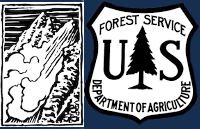We rode up to Fairy Lake area today and quickly found out just how warm it has been in this area the last two days. At the trailhead at 10am temperatures were around 47 degrees. Last night, it did not freeze below 9000' and an isothermic snowpack now exists from the trailhead all the way to Fairy Lake and above, until you pop out into Airplane Bowl. When we returned to the trailhead around 2:30pm, it was 65 degrees at the truck.
While higher elevation southerly and easterly snowpacks were warm and wet, free water was only moving through the upper few inches of the snowpack by 1pm. High elevation northerly aspects remained colder and more locked up than we expected given the ambient air temperature. Winds were light from the W and were doing little to keep surfaces cold.
There were a number of wet loose avalanches in Airplane Bowl when we were heading out around 2pm. All on E/S aspects near rocks or cliffs. Most were relatively small and had not entrained much snow from the surface or gouged deeper than a few inches.
On the drive back to town, we noted 5 or so larger wet loose avalanches in Argentina Bowl, with a good number of smaller slides at different points along the ridge
Seeing as it is now the season for wet snow hazards, there are a few things that are critical to consider: aspect, elevation, and timing.
Timing your day to be off of steep slopes before melt water percolates too deep and destabilizes the slope is key, AND making sure to account for steep low-elevation slopes that you may have to pass through on your way back to the trailhead. If you start to sink in deeper than your ankles, or your sled track is digging into slush, that means it is time to either shift to colder aspects or head back to the trailhead.
Our greatest concern with these wet loose avalanches is not so much their size, but their power to push you into terrain traps like cliffs, gullies, trees, or rocks. The two scenarios when we are most concerned about these avalanches are when new snow gets wet and sheds for the first time OR when there have been multiple days without a solid refreeze and melt-water percolates deep into the snowpack.
